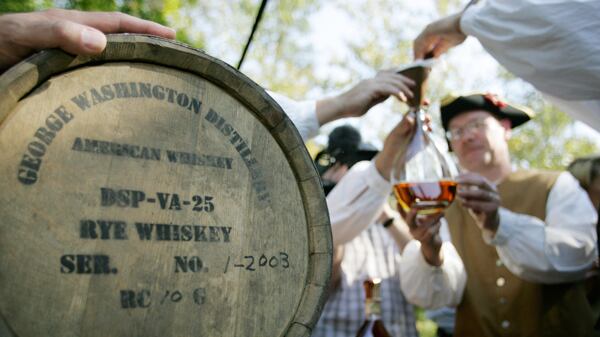Rye whiskey is America's spirit, arguably even more than bourbon. When the British blocked American ports during the Revolution, preventing molasses shipments from getting in, the colonists forewent rum and instead made rye whiskey with local grain. (Take that, redcoats!) Revolutionary soldiers were given rye whiskey rations to get through the day. George Washington eventually created a wildly successful business distilling, selling and trading it. Bourbon came later.
"Truly, America was settled on the back of rye whiskey and our independence was won on the back of rye whiskey," says Dave Pickerell, a master distiller and spirits consultant for brands like Hillrock Estate Distillery, WhistlePig, and George Washington's Distillery & Gristmill at Mount Vernon.
Yet many Americans don't even know about it. I was first exposed to this dilemma last fall while leading a tasting of three American whiskeys at a popular Washington, D.C. restaurant: Elmer T. Lee, a soft, honeyed bourbon, Eagle Rare, a robust and oaky bourbon, and Sazerac Rye, a spicy and dry rye whiskey. Though the attendees varied from whiskey enthusiasts to novices, most said they liked the rye best. And many said they had never tasted it.
Rye whiskey has had a tough go of it, and Prohibition and two World Wars certainly didn't help. After World War Two, Rye also fell out of the favor of farmers and consumers alike, relegated to a cover crop and deemed a noxious weed by many states. Most rye distilleries were closed by the 1970s, says spirits expert Noah Rothbaum, author of The Business of Spirits and forthcoming Art of American Whiskey. Kentucky bourbon makers then bought many of the surviving rye brands. They could produce rye whiskey just one day a year to meet demand.
But the craft spirits movement has changed that in recent years, creating sophisticated drinkers who like rye's spicy and dry characteristics that balance sweet and fruity ingredients beautifully in cocktails, and also drinks well neat.
Sales of rye whiskey grew 34 percent in 2013 alone and 500 percent over the past five years, according to the Distilled Spirits Council of the United States, though it could not provide dollar amounts or production volume numbers. Pickerell estimated the number of rye cases sold in 2006 to be tiny- 150,000. In other words, it has gone from a miniscule category to a pretty small category when compared to bourbon, tequila, rum or vodka.
Pickerell describes the launch of the premium WhistlePig rye whiskey in 2010 as being a "combination of foresight and guts" because rye was so unheard of the business could have been a colossal failure. Though several craft distilleries have successfully brought rye whiskeys to market since then, distributors often move the allocation to where the product is hot, eliminating the possibility of attracting new fans in the middle of the country or outside of cosmopolitan cities.
Though decent ryes take anywhere from five to 10 years to age, there's also a shortage of grain that no one is talking about and that bourbon producers don't have to worry about as much; one that has distillers scrambling to compete for a crop that used to be worthless. "We [distillers] can be very collegial most of the year but when it's rye harvest, everyone is fighting tooth and nail for rye," Pickerell says, particularly in states that require distilleries to use a certain amount of grain grown in-state.
To try to ease the burden, some producers purchase rye from Canada, while others have started growing their own. Hillrock has even brought in a rye strain from Germany, which is plumper, more hardy and juicier than American ryes.
As a result, distilling whiskey can present a profitable line of a business to a farmer who is already growing or could easily grow rye or corn. Rye was formerly most fruitful and prevalent mid-Atlantic; now the best states for growing rye are colder places like New England, Minnesota, Montana, the Dakotas and the like.
Though the American Craft Spirits Association does not have official numbers, Pickerell estimates the number of distillers growing their own grains (whether or not they were farmers before they were distillers) to be less than 20. But we may see more distillers taking up farming in the future to meet their supply needs.
Like bourbon, rye must be aged in charred oak barrels for at least two years. But it does not have to be made in the United States to be called a rye whiskey like a bourbon does. Rye is made with at least 51% rye, while bourbon is made with at least 51% corn, which gives it the sweetness. Bourbons rarely are made with more than 70 percent corn, but often ryes often contain more than 70 percent of rye, with some of the best being 100 percent rye.
The future of the rye category is bright, especially if more people are able to get their hands on it long enough to fall in love. But executive director of the American Craft Spirits Association Pennfield Jensen predicts the limited supply issue will result in survival of the fittest for producers. "We're going to see many more ryes on the shelves and there's going to be a wash-out of ryes that will capture the market," he says.
So if you haven't tried rye or at least not many, now's the time to seek them out. Ask your local liquor store and bar for rye, and if they don't have it ask them to order it. Talk to your local distillers. Tell local farmers you'd like to see it around. It's just the patriotic thing to do.





